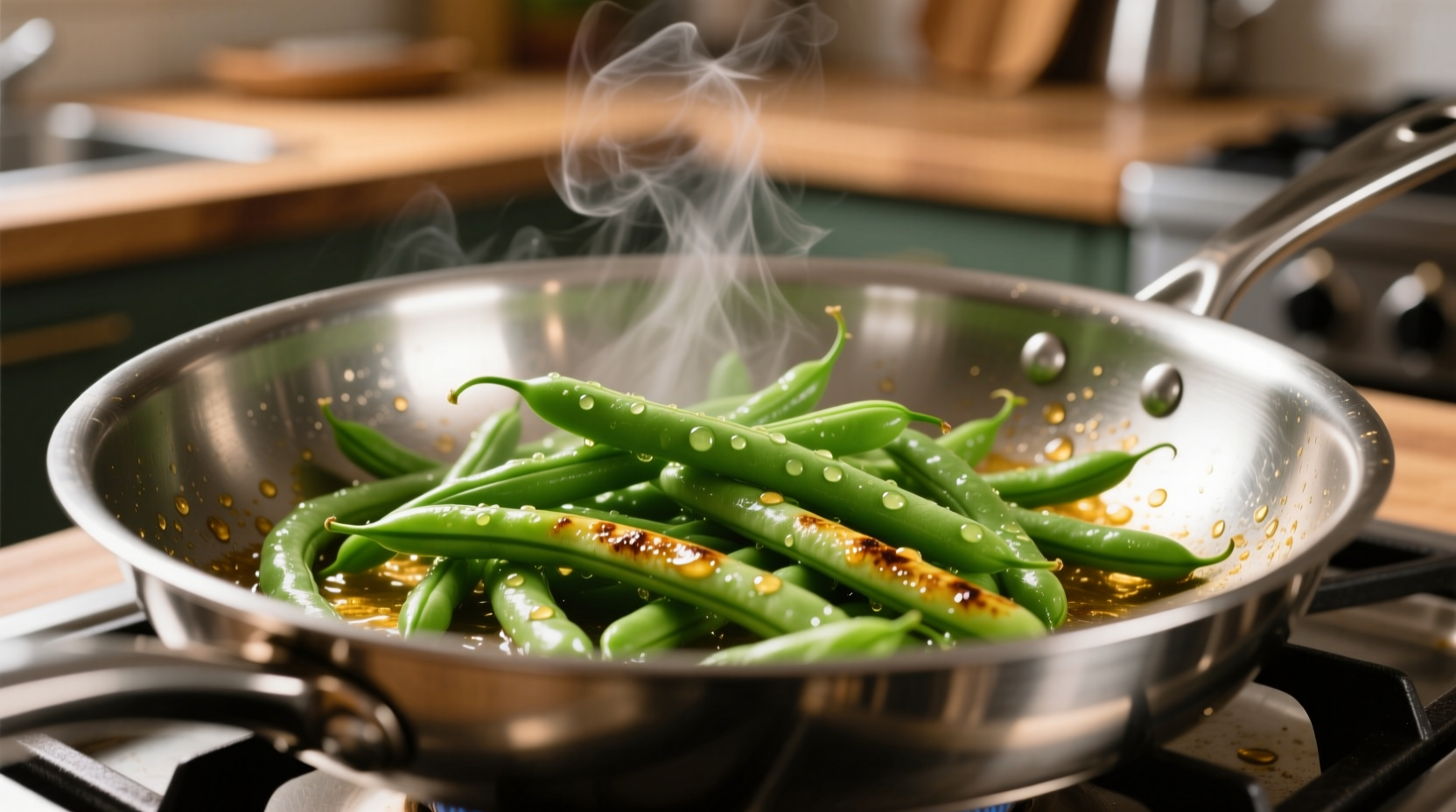Perfectly cooked fresh green beans on the stove take just 8-12 minutes with this simple method: wash and trim 1 pound of beans, sauté in 1 tbsp oil over medium-high heat for 2 minutes, add 1/4 cup water, cover and steam for 6-10 minutes until crisp-tender, then season with salt and pepper. This technique preserves nutrients while achieving ideal texture every time.
Why This Stovetop Method Beats Other Cooking Techniques
When you're craving vibrant, crisp-tender green beans without the hassle of boiling or roasting, the stovetop method delivers restaurant-quality results in minutes. Unlike boiling—which leaches nutrients into water—this technique uses minimal liquid to steam the beans right in the pan, preserving up to 30% more vitamin C according to USDA cooking studies. The direct heat contact also creates those desirable caramelized spots that elevate flavor without adding extra fat.
| Cooking Method | Time Required | Texture Result | Nutrient Retention |
|---|---|---|---|
| Stovetop Sauté-Steaming | 8-12 minutes | Crisp-tender with caramelized edges | High (up to 30% more vitamin C) |
| Boiling | 10-15 minutes | Often mushy | Moderate (nutrients leach into water) |
| Oven Roasting | 20-25 minutes | Very tender with deep caramelization | Good (but longer cooking time) |
Selecting the Best Fresh Green Beans
The foundation of perfect green beans starts at the market. Look for pods that snap crisply when bent—this "snap test" indicates peak freshness. Vibrant green color without yellowing or blemishes signals optimal maturity. While French haricots verts (thinner beans) cook faster (6-8 minutes), standard green beans require the full 10-12 minutes. Avoid limp or rubbery beans, which indicate age and will never achieve that desirable crisp-tender texture.
Step-by-Step Cooking Process
Preparation (2 minutes)
Wash beans under cold running water, then lay them on a clean kitchen towel. Trim both ends using a sharp chef's knife—this isn't just cosmetic; the tough ends prevent even cooking. For uniform results, cut larger beans in half. Pro tip: Don't soak beans beforehand, as excess water creates steam that prevents proper searing.
Sautéing for Flavor Development (3 minutes)

Heat 1 tablespoon of avocado oil (smoke point 520°F) in a 12-inch stainless steel skillet over medium-high heat. Add beans in a single layer—crowding the pan lowers temperature and causes steaming instead of searing. Cook undisturbed for 2 minutes to develop those essential Maillard reaction flavors, then toss gently with tongs for even browning.
Steaming to Perfect Tenderness (6-10 minutes)
Pour 1/4 cup water around the edge of the pan (avoiding the beans directly), then immediately cover with a tight-fitting lid. Reduce heat to medium and set timer for 6 minutes for haricots verts or 8 minutes for standard beans. Check texture at intervals—perfect beans should bend slightly but still offer resistance when pierced with a fork. Overcooking by just 2 minutes turns crisp-tender beans to mush due to their high water content.
Avoid These Common Green Bean Mistakes
Even experienced cooks make these critical errors that compromise results:
- Salt too early: Adding salt before cooking draws out moisture, preventing proper searing. Wait until the final minute.
- Using cold water: Room temperature water creates more consistent steam than cold water from the tap.
- Peeking too often: Each lid lift releases steam, extending cooking time by 1-2 minutes per check.
- Skipping the sear: Direct contact with hot metal creates complex flavor compounds that steaming alone can't achieve.
When This Method Works Best (and When to Choose Alternatives)
This stovetop technique shines for weeknight dinners when you need speed and simplicity. However, consider these context boundaries:
- Best for: 1-2 servings, when you want maximum flavor development with minimal equipment
- Not ideal for: Large batches (over 1.5 pounds), where oven roasting provides more even results
- Alternative for meal prep: Blanch then shock in ice water if cooking ahead—reheat briefly in pan before serving
Serving Suggestions That Elevate Your Green Beans
Transform basic green beans into a standout side with these chef-tested combinations:
- Classic French: Finish with 1 tsp lemon zest and 1 tbsp toasted almonds
- Mediterranean: Toss with 1 minced garlic clove, 2 tbsp chopped parsley, and 1 tsp lemon juice
- Asian-inspired: Add 1 tsp sesame oil and 1 tbsp toasted sesame seeds after cooking
For optimal flavor integration, add acidic elements like lemon juice or vinegar in the last 60 seconds of cooking—earlier addition can prevent proper softening of bean fibers.
Proper Storage for Leftover Green Beans
Store cooled beans in an airtight container with a slightly damp paper towel for up to 3 days. Reheat gently in the skillet with 1 tsp water to revive texture—microwaving often makes them rubbery. Freezing is not recommended as their high water content causes texture degradation.
Frequently Asked Questions
Can I cook green beans without oil? Yes, but you'll miss out on flavor development from the Maillard reaction. For oil-free cooking, increase water to 1/3 cup and expect slightly less complex flavor.
Why do my green beans turn brown during cooking? This happens when water evaporates completely and beans burn. Maintain proper liquid levels and avoid cooking over high heat.
How can I tell when green beans are perfectly cooked? They should bend slightly when lifted with tongs but still offer firm resistance when pierced with a fork—like the tension of a guitar string.











 浙公网安备
33010002000092号
浙公网安备
33010002000092号 浙B2-20120091-4
浙B2-20120091-4